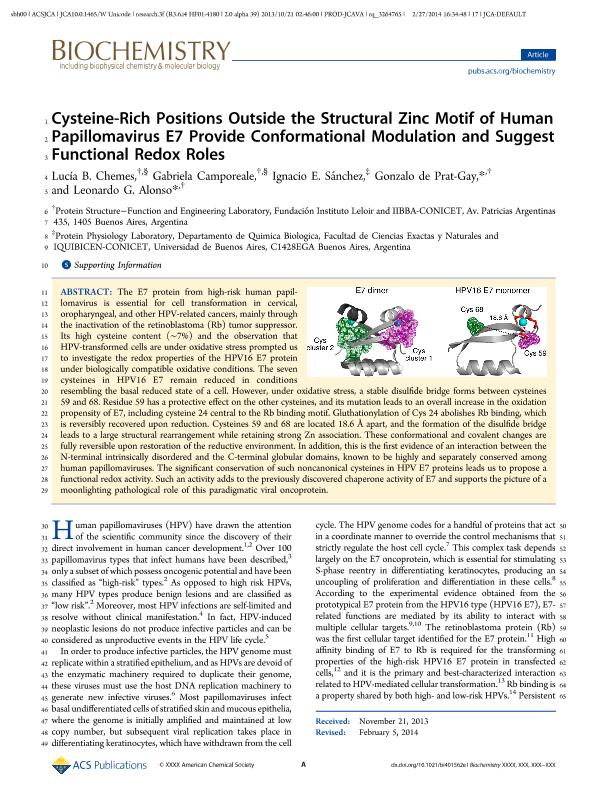Mostrar el registro sencillo del ítem
dc.contributor.author
Chemes, Lucia Beatriz

dc.contributor.author
Camporeale, Gabriela

dc.contributor.author
Sánchez Miguel, Ignacio Enrique

dc.contributor.author
de Prat Gay, Gonzalo

dc.contributor.author
Alonso, Leonardo Gabriel

dc.date.available
2016-11-30T19:59:58Z
dc.date.issued
2014-02
dc.identifier.citation
Chemes, Lucia Beatriz; Camporeale, Gabriela; Sánchez Miguel, Ignacio Enrique; de Prat Gay, Gonzalo; Alonso, Leonardo Gabriel; Cysteine-rich positions outside the structural zinc motif of human papillomavirus E7 provide conformational modulation and suggest functional redox roles; American Chemical Society; Biochemistry; 53; 10; 2-2014; 1680-1696
dc.identifier.issn
0006-2960
dc.identifier.uri
http://hdl.handle.net/11336/8537
dc.description.abstract
The E7 protein from high-risk human papillomavirus is essential for cell transformation in cervical, oropharyngeal, and other HPV-related cancers, mainly through the inactivation of the retinoblastoma (Rb) tumor suppressor. Its high cysteine content (~7%) and the observation that HPV-transformed cells are under oxidative stress prompted us to investigate the redox properties of the HPV16 E7 protein under biologically compatible oxidative conditions. The seven cysteines in HPV16 E7 remain reduced in conditions resembling the basal reduced state of a cell. However, under oxidative stress, a stable disulfide bridge forms between cysteines 59 and 68. Residue 59 has a protective effect on the other cysteines, and its mutation leads to an overall increase in the oxidation propensity of E7, including cysteine 24 central to the Rb binding motif. Gluthationylation of Cys 24 abolishes Rb binding, which is reversibly recovered upon reduction. Cysteines 59 and 68 are located 18.6 Å apart, and the formation of the disulfide bridge leads to a large structural rearrangement while retaining strong Zn association. These conformational and covalent changes are fully reversible upon restoration of the reductive environment. In addition, this is the first evidence of an interaction between the N-terminal intrinsically disordered and the C-terminal globular domains, known to be highly and separately conserved among human papillomaviruses. The significant conservation of such noncanonical cysteines in HPV E7 proteins leads us to propose a functional redox activity. Such an activity adds to the previously discovered chaperone activity of E7 and supports the picture of a moonlighting pathological role of this paradigmatic viral oncoprotein.
dc.format
application/pdf
dc.language.iso
eng
dc.publisher
American Chemical Society

dc.rights
info:eu-repo/semantics/openAccess
dc.rights.uri
https://creativecommons.org/licenses/by-nc-sa/2.5/ar/
dc.subject
Cysteine
dc.subject
Redox
dc.subject
Papillomavirus
dc.subject
Zinc Binding
dc.subject.classification
Bioquímica y Biología Molecular

dc.subject.classification
Ciencias Biológicas

dc.subject.classification
CIENCIAS NATURALES Y EXACTAS

dc.title
Cysteine-rich positions outside the structural zinc motif of human papillomavirus E7 provide conformational modulation and suggest functional redox roles
dc.type
info:eu-repo/semantics/article
dc.type
info:ar-repo/semantics/artículo
dc.type
info:eu-repo/semantics/publishedVersion
dc.date.updated
2016-11-29T12:42:45Z
dc.journal.volume
53
dc.journal.number
10
dc.journal.pagination
1680-1696
dc.journal.pais
Estados Unidos

dc.journal.ciudad
Washington
dc.description.fil
Fil: Chemes, Lucia Beatriz. Consejo Nacional de Investigaciones Científicas y Técnicas. Oficina de Coordinación Administrativa Parque Centenario. Instituto de Investigaciones Bioquimicas de Buenos Aires; Argentina. Fundación Instituto Leloir; Argentina
dc.description.fil
Fil: Camporeale, Gabriela. Consejo Nacional de Investigaciones Científicas y Técnicas. Oficina de Coordinación Administrativa Parque Centenario. Instituto de Investigaciones Bioquimicas de Buenos Aires; Argentina. Fundación Instituto Leloir; Argentina
dc.description.fil
Fil: Sánchez Miguel, Ignacio Enrique. Consejo Nacional de Investigaciones Científicas y Técnicas. Oficina de Coordinación Administrativa Ciudad Universitaria. Instituto de Química Biológica de la Facultad de Ciencias Exactas y Naturales; Argentina
dc.description.fil
Fil: de Prat Gay, Gonzalo. Consejo Nacional de Investigaciones Científicas y Técnicas. Oficina de Coordinación Administrativa Parque Centenario. Instituto de Investigaciones Bioquimicas de Buenos Aires; Argentina. Fundación Instituto Leloir; Argentina
dc.description.fil
Fil: Alonso, Leonardo Gabriel. Consejo Nacional de Investigaciones Científicas y Técnicas. Oficina de Coordinación Administrativa Parque Centenario. Instituto de Investigaciones Bioquimicas de Buenos Aires; Argentina. Fundación Instituto Leloir; Argentina
dc.journal.title
Biochemistry

dc.relation.alternativeid
info:eu-repo/semantics/altIdentifier/url/http://pubs.acs.org/doi/abs/10.1021/bi401562e
dc.relation.alternativeid
info:eu-repo/semantics/altIdentifier/doi/http://dx.doi.org/10.1021/bi401562e
Archivos asociados
